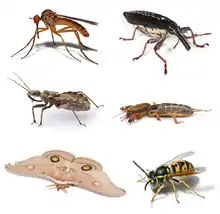Notoptera
The wingless insect order Notoptera, a group first proposed in 1915, had been largely unused since its original conception until 2006.
| Notoptera | |
|---|---|
 | |
| Mantophasma zephyra | |
| Scientific classification | |
| Kingdom: | Animalia |
| Phylum: | Arthropoda |
| Class: | Insecta |
| Cohort: | Polyneoptera |
| Order: | Notoptera Crampton, 1915 |
| Suborders & families | |
|
Suborder Grylloblattodea
Suborder Mantophasmatodea
| |
Phylogeny
Terry and Whiting in 2005 named the lineage of insects that includes the Grylloblattodea and Mantophasmatodea the "Xenonomia".[1]
In 2006, Arillo and Engel described a new (fourth) species of rock crawler,[2] noting that the name Notoptera had been resurrected and redefined following Engel and Grimaldi's 2004 recommendation to give a single order, "Notoptera Crampton (sensu novum)", that includes both the living and fossil representatives of the lineage.[3] Also in 2006, Cameron, Barker, and Whiting studied the mitochondrial genomics of the Mantophasmatodea.[4] In 2008, Damgaard and colleagues examined the mitochondrial genome of 8 described and 4 undescribed Austrophasmatid species, and some Mantophasmatids; the major clades were confirmed.[5] In 2012, Predel and colleagues studied the peptidomics of 71 populations of Mantophasmatodea, confirming that Austrophasmatidae are monophyletic, and noting that the development of the capa-neurons of the ventral nervous system implies a close relationship with the Grylloblattodea.[6]
Overview
As now defined, the order comprises five families, three of them known only from fossils, two known from both fossil and living representatives, and fewer than 60 known species in total.
Gallery

 A nymph of a mantophasmatid
A nymph of a mantophasmatid.jpg.webp) Grylloblattid
Grylloblattid
See also
References
- Terry, Matthew D.; Whiting, Michael F. (2005). "Mantophasmatodea and phylogeny of the lower neopterous insects". Cladistics. Wiley. 21 (3): 240–257. doi:10.1111/j.1096-0031.2005.00062.x. ISSN 0748-3007.
- Arillo, Antonio; Engel, Michael S. (2006). "Rock Crawlers in Baltic Amber (Notoptera: Mantophasmatodea)" (PDF). American Museum Novitates. American Museum of Natural History (BioOne sponsored). 3539 (1): 1. doi:10.1206/0003-0082(2006)3539[1:rciban]2.0.co;2. ISSN 0003-0082.
- Engel, Michael S.; Grimaldi, David A. (2004). "A New Rock Crawler in Baltic Amber, with Comments on the Order(Mantophasmatodea: Mantophasmatidae)". American Museum Novitates. American Museum of Natural History (BioOne sponsored). 3431 (1): 1. doi:10.1206/0003-0082(2004)431<0001:anrcib>2.0.co;2. ISSN 0003-0082.
- Cameron, Stephen L.; Barker, Stephen C.; Whiting, Michael F. (2006). "Mitochondrial genomics and the new insect order Mantophasmatodea". Molecular Phylogenetics and Evolution. Elsevier. 38 (1): 274–279. doi:10.1016/j.ympev.2005.09.020. ISSN 1055-7903.
- Damgaard, Jakob; Klass, Klaus-Dieter; Picker, Mike D.; Buder, Gerda (2008). "Phylogeny of the Heelwalkers (Insecta: Mantophasmatodea) based on mtDNA sequences, with evidence for additional taxa in South Africa". Molecular Phylogenetics and Evolution. Elsevier. 47 (2): 443–462. doi:10.1016/j.ympev.2008.01.026. ISSN 1055-7903.
- Predel, Reinhard; Neupert, Susanne; Huetteroth, Wolf; Kahnt, Jörg; Waidelich, Dietmar; Roth, Steffen (2012-04-16). "Peptidomics-Based Phylogeny and Biogeography of Mantophasmatodea (Hexapoda)". Systematic Biology. Oxford University Press (OUP). 61 (4): 609–629. doi:10.1093/sysbio/sys003. ISSN 1076-836X.
External links
